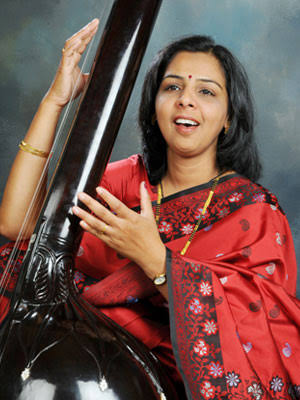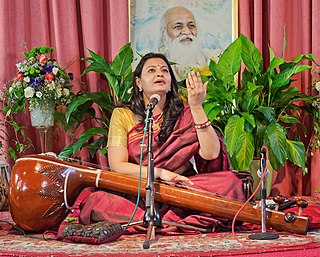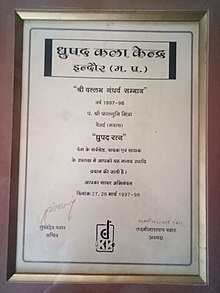Dhrupad is a genre in Hindustani classical music from the Indian subcontinent. It is the oldest known style of major vocal styles associated with Hindustani classical music, Haveli Sangeet of Pushtimarg Sampradaya and also related to the South Indian Carnatic tradition. It is a term of Sanskrit origin, derived from dhruva and pada. The roots of Dhrupad are ancient. It is discussed in the Hindu Sanskrit text Natyashastra, and other ancient and medieval Sanskrit texts, such as chapter 33 of Book 10 in the Bhagavata Purana, where the theories of music and devotional songs for Krishna are summarized.
Hindustani classical music is the classical music of the Indian subcontinent's northern regions. It may also be called North Indian classical music or, in Hindustani, shastriya sangeet. The term shastriya sangeet literally means classical music, and is also used to refer to Indian classical music in general. It is played on instruments like the veena, sitar and sarod. Its origins from the 12th century CE, when it diverged from Carnatic music, the classical tradition in South India. While Carnatic music largely uses compositions written in Sanskrit, Kannada, Telugu, Tamil, Malayalam, Hindustani music largely uses compositions written in Hindi-Urdu, Braj, Avadhi, Punjabi, and Rajasthani,.
In Hindustani music, a gharānā is a system of social organisation in the Indian subcontinent, linking musicians or dancers by lineage or apprenticeship, and more importantly by adherence to a particular musical style.
The Gwalior Gharana is one of the oldest Khyal Gharana in Indian classical music. The rise of the Gwalior Gharana started with the reign of the Mughal emperor Akbar (1542–1605).
Mushtaq Ali Khan and was an Indian classical sitar, surbahar player.
Pandit Vidyadhar Vyas is an Indian Hindustani vocalist, and a contemporary exponent of the Paluskar style of North Indian classical singing. He belongs to the Gwalior gharana and the lineage of Sangeet Maharshi Pandit Vishnu Digambar Paluskar contributed to his background.

Kaushiki Chakraborty is an Indian classical vocalist of the Patiala gharana. Her repertoire covers pure classical, Khyals, Dadras, Thumris, Bhajans and several other forms of Indian music. She is the recipient 2005 BBC Radio 3 Awards for World Music in the Asia-Pacific category. She is the daughter of noted hindustani classical vocalist, Ajoy Chakraborty. Kaushiki is also a trained Carnatic classical vocalist.

Ustad Abdul Rashid Khan was an Indian vocalist of Hindustani music. Apart from khayal, he performed dhrupad, dhamar and thumri. As of 2020, he is the oldest person to have been conferred a Padma award.
Chintaman Raghunath Vyas, popularly known as C. R. Vyas, was an Indian classical singer. He was known for singing khyal style.

Malabika Kanan was an Indian classical vocalist.

Lalith J. Rao is an Indian classical singer and a representative of the Agra gharana.
ITC Sangeet Research Academy is a Hindustani classical music academy run by the corporate house, ITC Ltd. It is located in Kolkata, India. Noted musicians associated with the academy include Ulhas Kashalkar, Falguni Mitra, Ajoy Chakrabarty, Ustad Rashid Khan, Mashkoor Ali Khan, Girija Devi, Subhra Guha. Satyajit Ray, was one of the trustees.

Jayashree R. Patanekar is a Hindustani classical vocalist. She has received training in Gwalior, Jaipur and Kirana gharana. She has received training from the great maestro Gajananrao Joshi.
Sanhita Nandi is a prominent Hindustani classical vocalist of the Kirana Gharana. The central motif of her style is slow tempo raga development and ornamented sargams. She is getting guidance under Mashkoor Ali Khan.

Manjusha Kulkarni-Patil is a Hindustani classical music vocalist. She belongs to the Gwalior gharana.

Pandit Vinayak Malharrao Torvi, is an Indian classical vocalist. He belongs to the Gwalior and Kirana gharanas.
Ustad Mashkoor Ali Khan is an Indian classical singer and teacher from the Kirana musical style. As the grandson of Abdul Karim Khan, a founder of the Kirana style, he is a descendant of the gharana's family lineage. He was educated by his father, sarangi player Shakoor Khan.

Meeta Pandit is a Hindustani Classical vocalist and a leading exponent of the Gwalior Gharana. She is the granddaughter and disciple of Krishnarao Shankar Pandit and daughter of Laxman Krishnarao Pandit. She is the sixth in the unbroken lineage and the first woman in the family to have taken up music as a profession.
Darbhanga gharana is a gharana, or tradition, of the Hindustani classical music dhrupad thought to have been started in the eighteenth century by Radhakrishna and Kartaram, musicians in the court of the Maharaja of Darbhanga. The style is notable for its vocal delivery and energetic performances, as well how the songs are sung after the alap. Notable singers of the Darbhanga gharana include Ram Chatur Mallick, Prem kumar Mallik and Siyaram Tiwari.
Arshad Ali Khan is an Indian classical singer belonging to the Kirana gharana.








